The initiation
The welfare of Sri Lankan Tamils has been very close to my heart since my childhood. That was way back in the 1980s, when large number of Sri Lankan Tamils had to flee their homeland. They reached the shores of several countries as refugees across the globe, most of them to Tamil Nadu in India.I have listened to the heartrending saga of tribulations and trauma from the refugees who sought asylum in Trichy, my hometown.The tragic exodus was triggered by what was to become a terrible 25 plus-year old civil war in Sri Lanka. It was brought to an end by a military campaign in 2009.
When I went to London to pursue postgraduate training in orthopedics, I stayed at the homes of Sri Lankan Tamils, and we used to spend several nights discussing possible solution to their problems – military versus political.

I returned to India in 2011, after a 15-year stay in London. I have since been actively associated with the Rotary International, as a member of the Rotary Club of Madras East, a part of RI District 3230. Project Dhanvanthri, a noble initiative of RI District 3230, under the leadership of PDG Sampathkumar and Chairmanship of PP Dhansekar, has been making significant improvements in the lives of people of North and Eastern Srilanka.
When I came to know about the Project, I enrolled myself to be part of the Dhanvanthri Team and visited Sri Lanka in February 2016, along with PDG Sampathkumar, PP Dhansekar, PP Ravi Ram, PP Govind Ram, PP Thanigaivelan, Rtn Sundaram and Mrs. Sundaram.
The visit to Srilanka
We attended in Colombo a two-daySilver Jubilee District Conference of the Rotary Clubs of Sri Lanka and Maldives. There was a very intense panel discussion on lot of issues faced by postwar Sri Lanka, like amendments to the Constitution, national government, national identity and strategies of addressing the root cause of the ethnic conflict.
The conference was attended by many young Tamil Rotarians from the North and the Eastern provinces of Sri Lanka, as well as from NuwaraEliya, the town in the hill country of the central province. All the members of the conference committee surprised us by turning up for the conference dinner, sporting Sarong,the Sri Lankan traditional dress.

The images
On the third day of our visit, we set off to Northern Sri Lanka by train. I never thought that I will be able to visit Jaffna in my lifetime. The rail track beyond Anuradhapura, devastated by war, has been restored after 25 years by the Indian Railways.
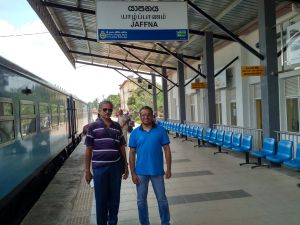 The scenery was breathtaking: we were able to see the enormous potential of developing tourism as an industryin the North, like in the Southern Srilanka. We reached Jaffna by lunchtime, and visited later the world famous Jaffna Public Library. It was shockingly the target of attack during the conflict, and was bombed and burnt.A huge collection of priceless books and ancient palm leaf manuscripts were destroyed and lost during the war.
The scenery was breathtaking: we were able to see the enormous potential of developing tourism as an industryin the North, like in the Southern Srilanka. We reached Jaffna by lunchtime, and visited later the world famous Jaffna Public Library. It was shockingly the target of attack during the conflict, and was bombed and burnt.A huge collection of priceless books and ancient palm leaf manuscripts were destroyed and lost during the war.
At the Jaffna Library, we met Mr. Sivalingam, MP from the Northern Province. He felt sad that there has been no improvement in the lives of commonTamils in the eight-year postwar period. So many of them still suffer from post-traumatic stress disorder and there is not enough specialists to treat them.
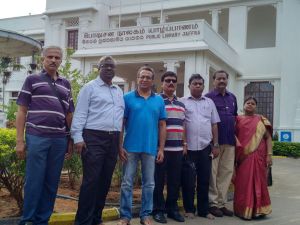
We visited Jaffna University and the Jaffna Fort as well. In the evening, we participated in the meeting of the Rotary Club of Nallur, Jaffna, and exchanged the flags. It was really touching to see so many young people becoming members of Rotary social service to work for the community.
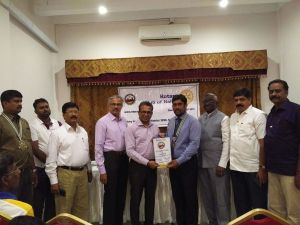
Later in the evening, we discussed the Sri Lankan Tamil community’s proposal to the Government, enlisting amendments for the new Constitution. The young Jaffna Rotarians were all appreciative of the secular, democratic and pluralistic Indian Constitution, enshrining equal rights to all its citizens.

We analysed the root cause of the conflict and all of us hope fervently that the new Constitution would ensure its Tamil citizens’ equal rights and absorb them into the mainstream of the society.
The fourth day of our visit coincided with the birthday of Rtn Sundaram, a member of our team. We started the day offering prayers at the temples of Jaffna, including the famous Nallur Murugan temple. Then, we travelled to Mullaitivu, where the final stages of the war had unfolded the darkest moments of Sri Lankan history.
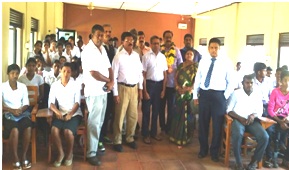
We visited the vocational training centre there, which trains more than 100 students in various disciplines. RI District 3230 has been offering cash allowance to these students to cover the costs of conveyance and lunch; many of them were orphaned by the terrible war. The allowance for the month of February was sponsored by Rtn Sundaram. I couldn’t control my tears when I interacted with these students all in late teens: they had witnessed the tragic moments of the war and now facing an uncertain future, because of the lack of economic opportunities.

The war memorial
There is, in the site of the last stages of the war, a war memorial has been erected, which is nothing but a jingoistic display of supremacy of the majority and military might. This concrete structure of insensitivity will always stand in the way of winning hearts and minds of already battered and bruised community. None of us wanted to take a photo in front of the repulsive war memorial.

The plight of women
We returned to Kilinochchi in the evening to attend the Rotary meeting. The lone woman Rotarian was a Sinhalese counselor. She narrated how overwhelming her work has been: the majority of the households there are left with only women; their men of the age group 20-50 were all killed in the war. The Indian Government has made significant efforts to restore the physical infrastructure. But, restoration of the social fabric and reconciliation has to come from within.
The chasm between works ‘done’ and ‘to be done’
On the final day of our visit, we distributed devices like wheel chair, crutches and bicycles to the devastated victims of war. Among the recipients was an 11-year old boy, who lost both his legs in the war. A whole generation has been lost in the war and we were humbled by the realization that Project Dhanvanthri is a small gesture to restore the civil society in Northern Sri Lanka.

With a heavy heart and many unanswered troubling questions, we got onto the train back to Colombo and then flew to Chennai. Sure, I will go again to Sri Lanka shortly to play my own part, however small it might be, towards the reconciliation and rehabilitation of the Tamils there; we in the mainland Tamil Nadu are connected to them by a strong emotional, cultural and social umbilical cord.
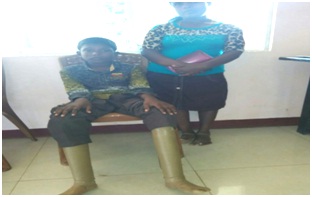
The visit also reaffirmed my belief that the Rotary is the single greatest service organization in the world and kudos to the RI District 3230 for the Project Dhanvanthri in Srilanka
